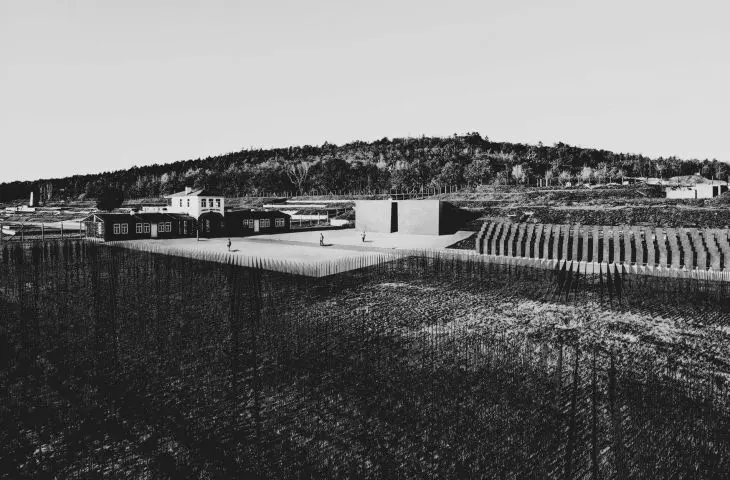Work submitted for the competition
"Best Diploma Architecture"
The basis for the topic was the question: is the memory of black pages in world history able to protect us from similar events in the future? A well-known claim mentioned by historians is the words of George Santayana: "He who does not remember history is doomed to relive it".
bird's eye view
© Tomasz Bekas
Considering the various contexts, as well as the picture of contemporary reality, we can see how much we have underestimated such a view in recent decades as a society. Current world events bring up the context of war, the lack of respect for individual life, and also draw attention to how important it is becoming to keep the image of past events still alive. That is why it is so important to cherish the places that witness them.
view of concrete blocks and bars
© Tomasz Bekas
The project is an attempt to touch on this topic by focusing on the area of the former German Nazi concentration and extermination camp Gross-Rosen in Rogoznica. The area, as a result of a number of processes devastating the historical fabric present there, has become a place of marginal importance and requires special attention. Much of the traces of its functioning have been obliterated, and further transformations are taking place there over time. How to deal with the existing space to make it a place of remembrance and serve both to respect what has passed and to those visiting it today?
a breakthrough in the rock
© Tomasz Bekas
The project was a response to the search for a relationship between the memory of past events and the spaces that witness them. Focusing on the interplay between these two concepts, attempts were made to penetrate the essence of martyrological sites. The increasing rush of life, consumerism, overstimulation, as well as the lowering of social sensitivity led to the clear conclusion that physical contact with the space becomes a necessity, as the ability to receive difficult experiences requires the creation of an appropriate environment. It is therefore important to convey memory as something that can be experienced, in isolation from what we are used to.
Camp blocks, barbed wire sculptures
© Tomasz Bekas
The desire to recreate communing with memory in the context of the events of World War II directed the research work toward the emotional experiences of the audience. The conclusion was put forward that some of the emotions experienced at the sites of martyrdom overlap with those perceived in the broader architectural spaces. Focusing on different types of emotions, a base of feelings accompanying them was created. The overriding goal, and at the same time the idea of the project, became the stimulation of these emotions using architectural tools. Particularly in areas where the found matter was not enough to achieve appropriate results. The use of contemporary materials and forms allowed interference in heavily transformed areas, so as not to recreate the historical space, but to improve the feeling of the aura of the place. Avoiding reconstructive activities, the focus was on bringing out the intangible and non-physical message.
commemoration, 125,000 rods
© Tomasz Bekas
The area of the entire camp was divided into zones defining the degree of its transformation. The design structure is based on three main parts: introduction, education — reception of stimuli — climax, extinction of tension. The placement of the various design elements and the determination of the narrative order were directly derived from the above. The established direction of transition prepares the user to receive stimuli and penetrate the camp area with due respect.
mausoleum
© Tomasz Bekas
The main axis of the project became putting the viewer in the center and focusing on his personal, internal experience. The simplicity and austerity of the materials used make it possible to read and understand the spatial treatments used, while also making it easier to distinguish between added elements and those of a historical nature.
interior of the mausoleum
© Tomasz Bekas
The emotions evoked by moving through the designed space revolve around the sensation of scale, weight, texture, and light intensity, among other things. Contrast, contradiction and upsetting familiar archetypes and proportions lead to discomfort and stepping out of one's comfort zone. A space tailored specifically for "experiencing memory" thus becomes the result of an exploration of the relationship between space and memory.
Tomasz BEKAS
Illustrations: © Author


































































